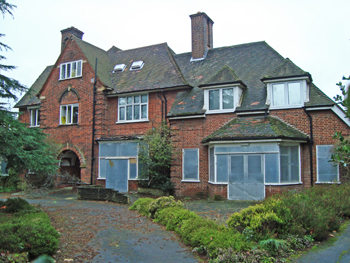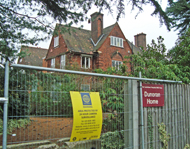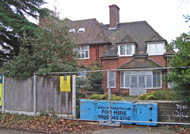Chronic (young), long-stay
There was also little nursing care for the dying, while young handicapped adults with chronic neurological conditions, such as multiple sclerosis, often found themselves admitted to geriatric wards. After the war, Dr Morton was one of the first to provide residential accommodation for such patients. She had founded the Brook Lane Medical Mission in 1937 and, in 1945, she purchased Dunoran, a large house in Bickley, where nursing care for severely handicapped young adult patients or the terminally ill could be provided.
The Home had 28 beds and was staffed by 4 nurses, 3 assistant nurses, 3 domestics and a gardener.
In 1948 the Home was initially disclaimed from the NHS, but joined it in 1949 under the control of the Bermondsey and Southwark Hospital Management Committee, part of the South East Metropolitan Regional Hospital Board.
To make more room for patient beds, a nearby house was purchased for use as a Nurses' Home.
By 1953 the Home had 36 beds. The nursing staff consisted of a Matron, five S.R.N.s, 12 orderlies, two domestics and a cook. The weekly cost of an in-patient was £12, which was considered rather expensive by the Regional Hospital Board. Seven patients were suffering from terminal cancer and the others from various neurological disorders.
In 1957 plans were made to extend the Home to create as extra 26 beds for the chronic sick. As well as patients with inoperable cancer, those with spasticity, post-encephalitis, disseminated sclerosis (including cervical cord lesions), arthritis, Friedreich's ataxia, myasthenia gravis and other types of muscular dystrophy, TB enteritis, congenital heart disease and transverse myelitis were admitted. The extensions, however, do not seem to have been carried out, probably due to lack of funding.
In 1965 the Home transferred to the control of the Guy's Hospital Group.
Following a major reorganisation of the NHS in 1974 the Guys's Hospital Group became the Guy's (Teaching) District Health Authority of the Lambeth, Southwark and Lewisham Area Health Authority, part of the South East Thames Regional Health Authority.
In 1982, after another reorganisation of the NHS, the Home came under the control of Lewisham and North Southwark District Health Authority. The Home had 18 beds, four of which were used for short-stay respite care, while the remainder were designated for permanent long-stay residents. The accommodation consisted of some single and some shared rooms.
By 1990 the Home had 30 beds.
In 1993, after another NHS reorganisation, it came under the control of the Lewisham Hospital NHS Trust.
In 2005 its future was in doubt as the Trust debated whether it should be providing such care, which was more akin to a nursing home than to an acute ward.
By 2007 there were only 8 chronically disabled residents, who had been admitted following an acute phase of their illness from Guy's or Lewisham Hospital, or from their own homes. Their length of stay varied from 2 to 22 years. Three beds were reserved for patients who lived in their own homes, but needed respite care; they stayed on average from 1 to 2 weeks.
The Home closed in 2009 as the Trust considered the building was no longer appropriate for use as as a modern long-term nursing home. It had only one lift, which was too small to contain a hospital bed, although it was used by wheelchair users to access the upper floor. The building and its extensions had different levels on each floor, making access difficult. The rooms lacked en-suite facilities, were not carpeted and did not provide privacy for those who had to share.
Present status (January 2010)
The locally listed building is now closed and vacant. It is proposed to demolish the extensions and outbuildings and to convert Dunoran into six 3-bedroom and one 2-bedroom maisonettes. A new extension would be added to the north side of the house. Two new detached houses would be built at the northwest part of the 0.57 hectare site, with a new access road.

The Arts and Crafts-style building has many extensions and outbuildings.


The property awaits redevelopment.
(Author unstated) 1998 A Rich Past...An Exciting Future. London, The Lewisham Hospital NHS Trust.
Morton BG 1964 Correspondence. Handicapped children. British Medical Journal 1 (5378), 376.
http://cds.bromley.gov.uk
http://sharepoint.bromley.gov.uk (1)
http://sharepoint.bromley.gov.uk (2)
www.lewisham.gov.uk (1)
www.lewisham.gov.uk (2)
www.lewisham.nhs.uk
www.missioncare.org.uk
Return to home page